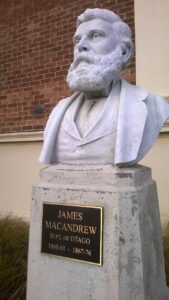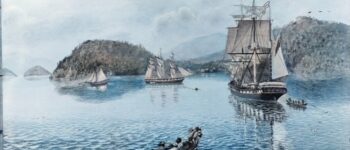1848: New Edinburgh
March 23, 2024
By AHNZ

Today in New Zealand history, 23 March, 1848, the first colony ship for the Otago Association landed and for this it has been Otago Anniversary ever since¹. This was a sub-project of the New Zealand Company facilitated by the Wakefield family and designed to be a Scottish intentional community. The New Edinburgh project had been proposed by politician George Rennie at the start of that decade but ripped away from him and his group by Calvanist sectarian Scots that schismed from the mainstream in 1843. The ship that arrived today, John Wickliffe, was supposed to be the vanguard of God’s true blessed ones.
In fact, Otago was far from unsettled and was home to dozens of families already. Apart from Johnny Jones’ people at Waikouaiti there were a few Maoris at Otakou to welcome and provide materially for the immigrants. Those already at home in Otago sent out their harbourmaster in his pilot boat crewed by Maoris to bring John Wickliffe in at Port Chalmers. The name for their home would be retained as Otago rather than New Edinburgh but the people themselves would be kicked out by the new elite. Not, however, until they had helped to build for these sanctified pioneers their raupo houses and saved them from starvation by feeding them from their farms. After that the locals were given the same treatment as Rennie and ousted from Presbertarian Utopia by the group that would start to call themselves the “Old Identities.”
 According to Otago Association propaganda in their Otago Journal and the speeches of leader William Cargill and shamen Thomas Burns everything was pure and peachy. The settlers were “selected with great caution, after careful scrutiny, and the production of the most satisfactory testimonials to character and blameless life.” according to the Journal on the occasion of the next ship: Philip Laing. Ref. Otago University Research Heritage
According to Otago Association propaganda in their Otago Journal and the speeches of leader William Cargill and shamen Thomas Burns everything was pure and peachy. The settlers were “selected with great caution, after careful scrutiny, and the production of the most satisfactory testimonials to character and blameless life.” according to the Journal on the occasion of the next ship: Philip Laing. Ref. Otago University Research Heritage
Captain Cargill said his colonists were imbued with the principles and habits of Scotch piety. Burns described them as the “better educated and more religiously disposed of the lower and middle classes..” Ref. A History of Otago, John McIndoe (1984)
Actually this first ship with Cargill on it, John Wickliffe, had few Scots at all but rather a motley selection of just 90 dominated by English, Anglican, settlers. Burns and Cargill had found it too hard maintain their idea of quality control in time for the first sailing. It was the second ship, Philip Laing, that had the main body of God’s Chosen Scotsmen. Both left at more or less the same time but Cargill’s ship arrived first despite his nearly being arrested at port for trying to shipping out with Burns’ kit-set house unpaid for. Thomas Burns and the Philip Laing arrived on 15 April. Ref. Journey to New Edinburgh, Otago Settlers Museum, Youtube (2023)
Cargill’s group were perhaps used to fulfill their purpose in establishing the colony before they were shown the door. Once the unloading was done, which took a very long period of disorganised bungling, many of those John Wickliffe passengers hopped right back on board again to be Wellington settlers instead. Perhaps they were let down by the infrastructure being less than promised. But perhaps Cargill and Burns were only too happy to rid themselves of the Out Group they came to call ‘The Little Enemy’.
“Hard to be self-flagellating, puritanical, anguished and dour when there are goldmines pumping wealth and booze and girls and song and luxury in your face!..The Celtic Puritan town was well inconvenienced. As a consolation, they did become wealthy and were able to build great infrastructure. The spiritual project was substituted for a temporal one. Still, the Dunedinites tried hard to be insufferable puritans. They didn’t even allow themselves to sing hymns and use a church organ for music until about 1901; That would have been way too much fun.” – 1955: Dunedin Inclined to Vanity, AHNZ
“Otago Colony had been in Crisis ever since it was founded in 1848 a Presbyterian Utopia by Elderly leaders trying to re-create their lost Scotland. William Cargill (d.1860) and Thomas Burns (d. 1870) both died in their 75th year having successfully transplanted fellow Scottish Calvinists away from the over-populated, urbanising, slummy, industrial, rural poverty, and ‘spiritually corrupted’ homeland. ” – 1861: The Invasion of Otago, AHNZ
” Cargill quickly demonstrated why he had never been promoted to a rank higher than Captain. Although punctilious about housing his own family in a style appropriate to their status, he proved to be lacking in organisational skills. It took three months of bungling to unload the first two ships; by then the supplies had been exhausted. Had it not been for Johnny Jones’s farm at Waikouaiti, the Maoris at Otakou, and the farm called ‘Kelvin Grove’ the migrants would have starved.” – McIndoe (1984)
Burns’ group, despite public relations communications to the contrary, were also not living up to the high morals of God’s Chosen Underwear Abstainers. Burns wrote in his journal how the colonists used bad language, stole from each other, and didn’t attend his church services. Bullying, domestic violence, strandings, and “absolute misery” tested the migrants and found them wanting in piety.
 So, the Otago Cult wasn’t really an authentic group with shared values as much as it was whipped into shape by an elite of old men: Cargill, Burns, John McGlashan, and William Bannerman were all Free Church Scots on the rebound. They had infiltrated Rennie’s project and taken it from him then infiltrated Otago and taken it from those settlers. The first years continued to be a crisis for the pure ones who purged themselves of anyone unlike themselves from the territory they has purchased and wished to preside over. They wanted to be an ethnostate or at least ethnoprovince. The Scottish Pilgrims had seen off the “hordes of loose characters” who were there before them and who came to Otago since so that by 1852 the session minutes of one of their courts “reported with an air of satisfaction that “most of them had removed themselves.” Ref. p63 Fairness and Freedom, David Fischer (2012)
So, the Otago Cult wasn’t really an authentic group with shared values as much as it was whipped into shape by an elite of old men: Cargill, Burns, John McGlashan, and William Bannerman were all Free Church Scots on the rebound. They had infiltrated Rennie’s project and taken it from him then infiltrated Otago and taken it from those settlers. The first years continued to be a crisis for the pure ones who purged themselves of anyone unlike themselves from the territory they has purchased and wished to preside over. They wanted to be an ethnostate or at least ethnoprovince. The Scottish Pilgrims had seen off the “hordes of loose characters” who were there before them and who came to Otago since so that by 1852 the session minutes of one of their courts “reported with an air of satisfaction that “most of them had removed themselves.” Ref. p63 Fairness and Freedom, David Fischer (2012)
What happened, though, when these elders died out? Otago’s next adult generation simply couldn’t relate to or appreciate the late 1700s Scottish nation that existed in Cargill’s and Burns’ memories that Otago was supposed to transplant, re-create, and preserve. The answer came with Gabriel Read’s invitation to the gold rush and ‘Slippery’ James Macandrew’s emphatic “Yes” as he rose to be Cargill’s successor as leader of a new era in Otago history.
—
1 Observed on the nearest Monday in a given year
Image ref. David Ogilvie Robertson painting; Christchurch Press; Alexander Turnbull Library; Colourised by AHNZ
Image ref. James Macandrew, AHNZ Archive (2018)
 Like Comment Share
Like Comment Share





